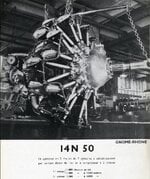Thank you.
The 1938 Janes (reprint) gives 536kg for a 14Kfs but that version is direct drive, no reduction gear. Possible source of confusion?
The 1938 Janes (reprint) also has a typo (?) as it gets the letters out of order (?) or leaves one out.
Trying to figure out the 14K letter code. I think the letter r in the 3rd position (K_r_ means reduction gear and s in last means supercharged?
Letter code maybe a hold over from the 7 and 9 cylinder engines?
In the 1946 edition of Wilkinson the 14N had gone on a diet and the -58 was now a svelte 620kg. Of course it had also lost 220hp at take-off from the 1941 edition as a -50
Yes. The 14K engine has continued to be improved and, above all, reinforced. It therefore gained weight throughout his life.
The very first versions (direct drive, no supercharging) weighed just over 500 kg.
Furthermore, we do not know if the weights given in commercial documents are the "standard" ones - engine equipped, but without exhausts and baffles. As for export electric generators, magnetos and fuel pumps could be changed, it is possible that the weights are given without these accessories.
For the name of French engines, it is correct: r for "réducteur" = reduction gear and s for "suralimenté" = supercharged. The preceding letter is the version, in pairs (a b, c d, ...., i j, ...) designating identical motors but rotating in opposite directions. After 1937, these designations (irs/jrs, for example) are remplaced by numbers, always in pairs as previously.
For the 1946 Wilkinson, it is true that post-war 14 N were slightly derated owing to some reliabiliy problems. But slightly only.... And attention ! The 14 N-50 does not exist, it is a 14R (much more powerful...). The 14R was presented at the 1938 Paris Aero salon under the name 14 N-50, undoubtedly for reasons of defense secrecy....
Last edited:

